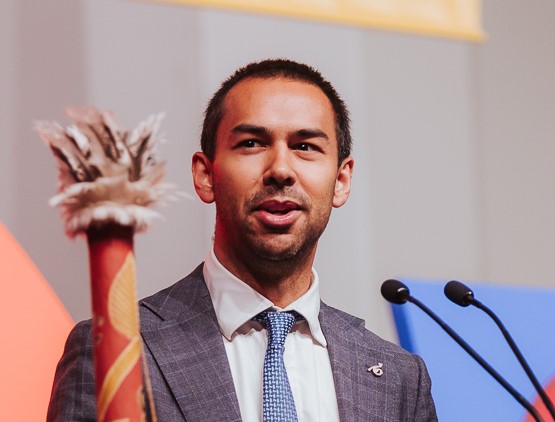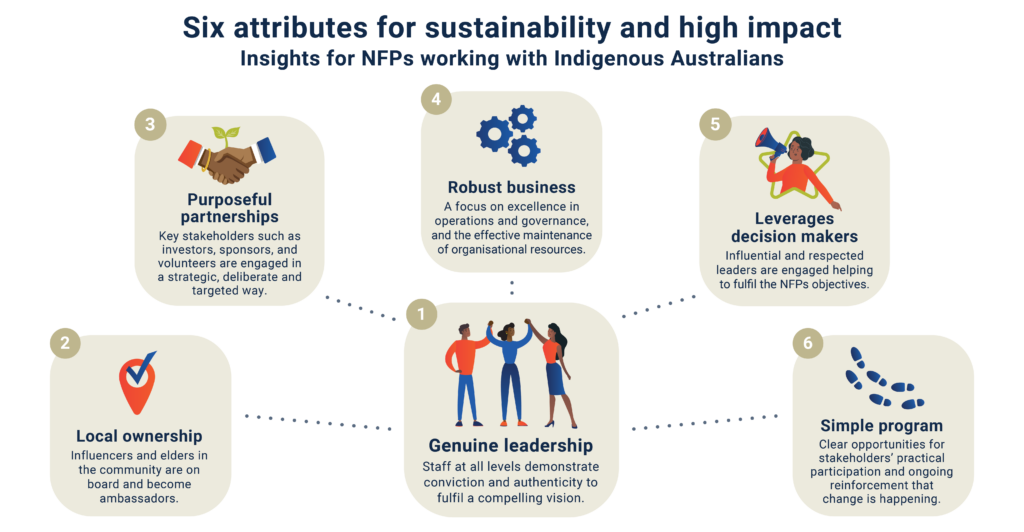
Developing sustainable and high impact NFPs for Indigenous Australians
SVA’s newest board member, Aboriginal non-profit leader and Fulbright Scholar, Adam Davids offers insights for Indigenous not-for-profits by drawing on the experience of successful racial minority-serving institutions in the USA.

- Following research as part of his Fulbright scholarship, Adam Davids has identified six attributes common across successful racial minority-serving institutions in the USA that have demonstrated longevity and high impact.
- The six attributes: genuine leadership, local ownership, purposeful partnership, robust business, leverages decision makers, and simple program can help develop more sustainable and higher impact NFPs for Indigenous Australians.
- One attribute, genuine leadership, is a foundational quality that must be embedded across the organisation, its decisions and behaviours.
- NFPs are encouraged to test the validity of the attributes within the organisation, with their boards and key stakeholders.
Growing up in rural and urban NSW, I remember seeing not-for-profits (NFPs) for Aboriginal people struggle to keep going and make a lasting impact. Aside from the institution of the Aboriginal Medical Centre, I remember seeing people with great intentions visit my school, with a good idea and the basis of a program – but they came and went at the blink of an eye.
Many times, at the whim of government funding cycles, I’ve seen programs and NFPs for Indigenous people fall short of becoming the ‘institution’ they had the potential to be and therefore fail to achieve their intended impact.
With these reflections in mind, I set out on a Fulbright exchange to the USA in 2019. I wanted to learn from some of the world’s longest-standing institutions that are recognised for their impact in achieving social, economic and political justice for racial minority people. What I found were six common attributes that contributed to their longevity and impact.
Reporting back on these attributes was my promise: to return to Australia and offer the NFP sector that serves communities experiencing vulnerability insights into traits that could help stimulate the sustainability and impact of their programs.
“… we as black people don’t often get good opportunities – those opportunities we do get are created by good community assets…”
The USA has a deep and historic ecosystem of non-government organisations (NGOs) that for more than a century has preserved the mission for racial justice socially, economically and politically for millions of Black, Hispanic and Native Americans. In Australia, we might be more familiar with civil rights leaders like Martin Luther King Jr and the sweeping policy changes he helped lead in the 1960s. However we don’t often give credit to the major NGOs that played just as big a role during this era and that have continued since.
At one of the first community gatherings I attended in the US, I was told that ‘we as black people don’t often get good opportunities – those opportunities we do get are created by good community assets like HBCUs’. This person was referring to the more than 100 Historically Black Colleges and Universities founded throughout the US between 1837 and 1964 that have become the staple higher education provider for black households.
More than 200,000 black Americans study at HBCUs across the US each year and some notable former students include the likes of Vice-President Kamala Harris, Oprah Winfrey (the first black American billionaire) and Justice Thurgood Marshall (the first black Supreme Court Judge). Several HBCUs contributed to my research as highlighted below.
I encourage NFPs for Indigenous Australians to consider learning from like-minded and long-standing NGOs for minorities in the US…
Both Australia and the US have a vibrant NFP and NGO community that engages with philanthropic, private and public sector institutions. The US sector may rely more heavily on philanthropic support than Australia, and Australian NFPs working for Indigenous Australians are highly vulnerable to the cycles of funding directed by government.
However there are a multitude of programmatic lessons in addition to the organisational attributes I have identified that translate well. So I encourage NFPs for Indigenous Australians to consider learning from like-minded and long-standing NGOs for minorities in the US of which there are many.
Research behind the attributes

My research involved interviews with more than 40 executives and founders (retired and current) as well as staff and participants of a variety of historic NGOs. Many are widely recognised for being pioneers as well as demonstrating their longevity and impact towards racial justice socially, economically and politically.
As I wanted to ensure that the insights were validated against more recently established NGOs, I also sought newer organisations that are widely recognised for their impact and establishing the foundations for sustainability.
Organisations were as diverse as the National Association for the Advancement of Colored People (NAACP), founded in 1909 and the largest civil rights organisation in the US; the United Negro College Fund (UNCF), founded in 1944 which works to help more African-American students attend and graduate from college; and INROADS Inc, started in 1970, which develops and places talented minority youth in business and industry and prepares them for corporate and community leadership.
The result of this research was the identification of six key attributes that the contributors regarded as key to their sustainability and impact. These are described below.
Practical use of the attributes
The attributes are framed as strategies, processes, behaviours and deep-seated philosophies. They provide a perspective about an organisation’s preparedness to tackle issues that affect its sustainability and impact.
… have a dialogue around the attributes with your board, staff and members to ask some difficult questions about where the organisation is, where it needs to be and how to get there.
Test their validity within your organisation, with your board and key stakeholders. Consider ways of leveraging these attributes to stimulate the sustainability and impact of your organisation.
It would be disingenuous to suggest that these attributes are the ‘be all and end all’ of ways to build sustainability. I would also caution any suggestion that they are a walk in the park to establish – especially for start-ups.
Consider the attributes as aspirational or a benchmark for where your organisation requires greater strength and capacity. You could have a dialogue around the attributes with your board, staff and members to ask some difficult questions about where the organisation is, where it needs to be and how to get there.
The six attributes
The six attributes are:
- Genuine leadership
- Local ownership
- Purposeful partnerships
- Robust business
- Leverages decision makers
- Simple program.
The interviews revealed that the sustainability of the organisation was under threat when just one single attribute was consistently violated or not practiced. This means that aside from each organisation’s unique mission and objectives, the six attributes are a core set of traits that stimulate sustainability and impact.
I found that these attributes were all mutually reinforcing and that ‘genuine leadership’ was firmly regarded as a foundational quality that must be embedded in the very fabric of the organisation, its decisions and behaviours.

I’ll explore each of these demonstrating some with examples.
1. Genuine leadership
Genuine leadership can be characterised by an NFP and all levels of its staff having the conviction to fulfil a compelling vision. A truly compelling vision must fundamentally appeal to a target group of beneficiaries. However NFPs that are genuine leaders tend to also have an ability to establish common interests with, and participation from, other stakeholders such as sponsors but without compromising their desired impact.
Genuine leadership is ultimately the legitimacy that an NFP establishes in its ecosystem.
This attribute is embodied in the very DNA of an NFP and at its best is present in the staff and culture at all levels within the organisation; everyone carries a leadership responsibility. When staff consistently demonstrate authenticity (why they’re committed to the vision) and this is evident in their approach (what they do and how they do it), the NFP can be seen as legitimate with its key stakeholders.
Genuine leadership is ultimately the legitimacy that an NFP establishes in its ecosystem. This is the catalyst for ensuring ongoing appeal among key stakeholders including beneficiaries.
Behaviours and initiatives that this showed up as included:
- Invests in a workforce that has deep ties to the issues, people and communities being served.
- Communicates a clear and compelling vision along with simple goals that are consistent among all stakeholders.
- Designates board positions for former program beneficiaries who represent the voices of the people the organisation serves. For example in 2019, Year Up which supports some 4000 youth a year to reach their potential through careers and training had four of its 21 national board positions filled by program alumni.
- Inspires staff to be actively engaged in the community beyond the program and its beneficiaries.
- Plays an active and authentic role in issues that affect beneficiaries and the desired impact of the organisation. For example, the National Association for the Advancement of Colored People (NAACP) has played an active and authentic role by being present at every major turn on the issue of civil rights and taking a swift and leading position in court to support the family of victims of police shootings.
2. Local ownership
Local ownership refers to the permission or buy-in that an NFP has from key influential people in the communities where the organisation operates. This does not refer to the legal ownership of the organisation but rather to the level of endorsement those people provide. These trusted leaders might include elders, parents, high school principals, mayors or trusted subject matter experts on issues that are important to the community being served. NFPs that best display this attribute go even further than securing permission from these individuals and organisations; they build a reciprocal relationship.
At its best it enables coordination of the whole ‘village’ to contribute to fulfilling the organisation’s goals.
NFPs that secure local ownership tend to appreciate the notion ‘that it takes a village to raise a child’ and through their local affiliations leverage relevant, local knowledge that might not be accessible to other people and organisations.
Local ownership can also deepen the impact of an NFP in a unique way. At its best it enables coordination of the whole ‘village’ to contribute to fulfilling the organisation’s goals.
Behaviours and initiatives include:
- Builds programs in new locations considering local cultures, etiquettes and business and community needs
- Creates opportunities for participation by the community around the program beneficiaries, e.g. for parents and elders
- Re-purposes existing program assets and finds mutually beneficial ways to share them with other members in the local community around the beneficiaries.
For example, the leading student internship program, INROADS created a parent support group to empower the interns’ parents. This simple initiative involved repurposing existing training materials like ‘how to interview’ and ‘financial management’ that were usually provided to students but were also needed by the parents.
In turn, the parent support group enabled a collaborative effort and multiplied the overall impact with student participants. With the buy-in from parents the value of the INROADS program was enriched for the students and the program absorbed local cultures and etiquettes.
3. Purposeful partnerships
Purposeful partnerships is about the manner in which NFPs engage key contributors such as investors, sponsors, like-minded organisations and volunteers (organisations and individuals). For example; rather than entering transactional relationships simply because they provide funding, NFPs that best display this attribute are more deliberate about partnerships and seek out win-win-win opportunities for their beneficiaries, partners and themselves.
Purposeful partnerships are rooted in principles around building longer term collaboration and therefore establishing foresight into the needs and trends of their partners. This continually brings value to the relationships.
Behaviours and initiatives include:
- Fulfils partnership expectations through an effective relationship underpinned by clear and mutually aligned goals
- Dismisses partnership opportunities that compromise core organisational objectives
- Starts new partnerships with modest goals to identify the ‘bugs’ in mutual processes before scaling up
- Compliments like-minded programs in the eco-system through partnership and advocacy that fulfils common goals.
For example, in the wake of COVID, the United Negro College Fund (UNCF) complimented key organisations in its ecosystem by advocating to congress and securing $1 billion for historically black colleges and universities (HBCUs).
The HBCU institutions serve a disproportionately high percentage of low-income and first-generation college students, UNCF’s cohort. The disruption of transiting to distance learning and assisting some students to return home had put unforeseen financial strains on those institutions which have historically been underfunded. UNCF lead the charge on calling for dedicated funding for these institutions.1
4. Robust business
A robust business refers to the healthy maintenance of an organisation’s resources. Robust businesses typically display operational and governance excellence that cater to the organisation’s model. NFPs that best display this attribute are agile and remain entrepreneurial even beyond their start-up years. This ensures the efficiency and adaptability to overcome setbacks such as those caused by the ebbs and flows of the economy or a changing policy landscape.
In a situation such as an unforeseen economic downturn that causes NFPs’ resources to be constrained, a robust business embraces entrepreneurialism to ensure that it continues to serve its purpose and fulfils its potential impact.
As much as NFPs depend on the effectiveness of their frontline teams, building a robust business depends on having an effective, well-coordinated and resourced back office team such as in finance and technology.
Behaviours and initiatives include:
- Implements internal systems to measure staff, program performance and longitudinal impact
- Approaches governance, financial and risk modelling deliberately
- Has an active board which bases selection on skills and influence with stakeholders
- Engages staff who are inspired by excellence and invests in their training and development
- Employs highly sought-after professionals with relevant expertise.
5. Leverages decision makers
Leveraging decision makers refers to how an NFP engages the most influential and respected leaders to fuel its work. It requires NFPs to firstly be clear about which leaders and institutions can help as well as potentially which could inhibit its overall sustainability and impact.
… they have the ability to influence decisions in favour of their desired impact such as making policy changes…
NFPs that best display this attribute go beyond just reaching the hearts and minds of leaders at the helm of institutions that matter. They convert those leaders’ advocacy in a way that directly fulfils the NFP’s program and organisational needs. At its best it involves leaders becoming active participants in the organisation at the grass roots or where the fundamental change is required.
When NFPs are positioned well to leverage decision makers, they have the ability to influence decisions in favour of their desired impact such as making policy changes or securing partnerships and expertise.
This could be that the NFP:
- Has an ability to network, engage and maintain relationships with ‘influential leaders’
- Requires senior level executives/leaders that serve on the board to contribute ‘time, talent or treasure’
- Co-hosts forums in partnership with ‘influential leaders’ to secure further participation and commitment in the ecosystem
- Engages ‘influential leaders’ to directly connect with program beneficiaries.
One such example of this was INROADS engaging General Colin Powell. Powell as US Secretary of State (2001-05) had been the highest ranking African American in the Federal executive (alongside Condoleezza Rice who succeeded him) prior to Barack Obama becoming US President in 2009. Powell helped to promote INROADS’ internship program with the aim of attracting corporate sponsors, potential participants, as well as inspire alumni to stay involved and support new interns.
6. Simple program
A compelling vision for change in the community can be manifested through several shapes and forms such as an NFP delivering a program, a well-designed communications campaign or a one-off protest. What differentiates sustainable and high impact NFPs is that they deliver programs that provide simple ways for their beneficiaries and the people from sponsoring organisations to participate and see the change. A simple program ultimately provides reinforcement to its stakeholders that the change they seek is happening.
… a simple program tends to clearly demonstrate how it fulfils their more urgent and/or long-term needs.
NFPs that best display this attribute have a clear and transparent program offering. They also require the engagement of beneficiaries and sponsors and their firm commitment to participate.
Maintaining active participation and simplicity in program delivery may not be straightforward; it may be complex operationally. However in the eyes of participants and stakeholders, a simple program tends to clearly demonstrate how it fulfils their more urgent and/or long-term needs.
Behaviours and initiatives include:
- Communicates clear expectations and program requirements with beneficiaries and key stakeholders
- Has clear program goals and holds itself accountable
- Has a high ‘personal touch’ through meaningful interaction with program participants to reinforce expectations and progress to making change
- Tends to be more focussed in its work by delivering fewer high impact programs within its area of expertise and vision rather than various diluted streams of work.
Founded in 1881, Spelman College is ranked the number one HBCU in the US and is a global leader in the education of women of African descent. Spelman has been recognised as the country’s leading educator of Black women who complete PhDs in science, technology, engineering and math (STEM).2
Spelman boasts a 76% graduation rate (one of the best in the US) and holds itself accountable by publishing a comprehensive set of success measures and subsequent achievements. The metrics are understood across the organisation and are at the forefront of its value proposition to students and its stakeholders. For these reasons, Spelman secures confidence in the community, is recognised for excellence and its high expectations are transparent.
Overcoming sponsor dependency
One of my biggest motivators for undertaking this research was to obtain insight into how we can build and preserve institutions (community assets) that continually drive equality for Indigenous Australians.
An issue discussed in Australia and the US is the challenge that programs face when they depend on few primary sponsors. For Indigenous NFPs it often means relying on government funding, being subject to short funding cycles and depending on the minister of the day to determine your legitimacy and viability. In the US it can include large private donors that control the funds to deliver programs the way they want them to be delivered rather than what the beneficiaries need.
NFPs tend to overcome issues that threaten their sustainability when they ensure ‘genuine leadership’ at all times…
Using these attributes, which stem from the living testimony of pioneers and long-standing, high impact NGOs for minorities in the US, I am certain that the path to get there does not depend on a government stamp of approval.
Also, the impact of long-standing NGOs for minorities in the US has resulted in many of the program beneficiaries themselves securing economic empowerment and paying it forward. They’ve returned to become the largest sponsors and donors – creating a virtuous cycle of change.
In my view, NFPs tend to overcome issues that threaten their sustainability when they ensure ‘genuine leadership’ at all times and take a holistic approach by working on all of the attributes. Depending on the situation, NFPs may need to prioritise the development of certain attributes and look at building them in stages.
During my career with NFPs I’ve seen a tension between several attributes which might also explain the demise of entire programs. Take for example the challenge between maintaining buy-in from the community you serve (‘local ownership’) and joining powerbroker circles to ‘leverage decision makers’ when the two groups have a history of being at odds with each other. This is an example of some tension you may need to manage.
Conclusion
I believe that in demonstrating all of the attributes NFPs can avoid being at the mercy of government funding cycles or being subject to serving the interests of few people. Instead, they can remain committed to their main beneficiary.
One way to adopt these attributes is to start by bringing this architecture into your board rooms and don’t be afraid to ask yourself and your organisation some difficult questions.
Thanks to the many pioneers in the NFP sector that came before us, we have an incredible opportunity to learn from their successes and challenges.
Author: Adam Davids
About the author
Adam Davids is the Director of Learning, at Career Trackers Indigenous Internship Program and was previously a Director of CareerSeekers New Australian Internship Program. He is a proud Aboriginal Australian and descendant of the Wiradjuri people. He is a Fulbright Scholar and for more than 12 years has worked in the non-profit sector to address the barriers facing Indigenous students in higher education and professional careers. He has been on SVA’s board since August 2020.
1. Congress responds to advocacy efforts from the HBCU community with emergency aid in stimulus, United Negro College Fund website
2. Spelman receives funding to establish a center of excellence for minority women in STEM, Spelman press release, Spelman website, accessed February 2021
I’d like to thank the key contributors to my research for sharing their lessons and for showing me the possibilities. This includes those who shared insights from INROADS Inc, Morehouse College, Urban League, Management Leadership for Tomorrow (MLT), Posse Foundation, Spelman College, United Negro College Fund, Year Up, National Association for the Advancement of Coloured People (NAACP) and American Indian Centre of Chicago.
Feel free to reach out if you would like any additional insights or if you would like to share your progress in building the sustainability and impact of your organisation.





